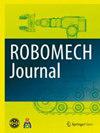基于激光雷达深度神经网络的自姿态估计与景观规律学习
IF 1.7
Q3 INSTRUMENTS & INSTRUMENTATION
引用次数: 2
摘要
提出了一种基于扩展卡尔曼滤波的自姿态估计方法,该方法利用LiDAR深度神经网络学习景观规律。提出的深度神经网络从LiDAR数据推断重力方向。激光雷达获得的点云被转换成深度图像输入到网络中。它是用大型合成数据集预先训练的。虽然本研究的重点不仅仅是无人机,但由于各种重力矢量可以很容易地获得,因此在飞行模拟器中收集它们。在预训练后对真实传感器采集的数据集进行微调。在训练过程中对数据进行增强处理,以提供更高的通用性。该方法将陀螺仪的角速率和深度神经网络输出集成到EKF中。静态验证表明深度神经网络可以推断重力方向。动态验证表明深度神经网络可以用于实时估计。实现了一些常规方法进行比较。本文章由计算机程序翻译,如有差异,请以英文原文为准。
LiDAR DNN based self-attitude estimation with learning landscape regularities
This paper presents an EKF (extended Kalman filter) based self-attitude estimation method with a LiDAR DNN (deep neural network) learning landscape regularities. The proposed DNN infers the gravity direction from LiDAR data. The point cloud obtained with the LiDAR is transformed to a depth image to be input to the network. It is pre-trained with large synthetic datasets. They are collected in a flight simulator because various gravity vectors can be easily obtained, although this study focuses not only on UAVs. Fine-tuning with datasets collected with real sensors is done after the pre-training. Data augmentation is processed during the training in order to provide higher general versatility. The proposed method integrates angular rates from a gyroscope and the DNN outputs in an EKF. Static validations are performed to show the DNN can infer the gravity direction. Dynamic validations are performed to show the DNN can be used in real-time estimation. Some conventional methods are implemented for comparison.
求助全文
通过发布文献求助,成功后即可免费获取论文全文。
去求助
来源期刊

ROBOMECH Journal
Mathematics-Control and Optimization
CiteScore
3.20
自引率
7.10%
发文量
21
审稿时长
13 weeks
期刊介绍:
ROBOMECH Journal focuses on advanced technologies and practical applications in the field of Robotics and Mechatronics. This field is driven by the steadily growing research, development and consumer demand for robots and systems. Advanced robots have been working in medical and hazardous environments, such as space and the deep sea as well as in the manufacturing environment. The scope of the journal includes but is not limited to: 1. Modeling and design 2. System integration 3. Actuators and sensors 4. Intelligent control 5. Artificial intelligence 6. Machine learning 7. Robotics 8. Manufacturing 9. Motion control 10. Vibration and noise control 11. Micro/nano devices and optoelectronics systems 12. Automotive systems 13. Applications for extreme and/or hazardous environments 14. Other applications
 求助内容:
求助内容: 应助结果提醒方式:
应助结果提醒方式:


